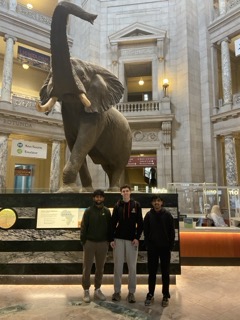Event name: Field Trip: National Museum of Natural History, Washington, DC
Event time and place: December 2nd, 2023, Washington, DC

Picture with Giant Elephant
Once we arrived at the museum, we first stopped at the temporary exhibit titled, "Cellphones: Unseen Connections," and focussed on the origins, history, and impact of cellphones. Within this exhibit, there were various presentation techniques such as models, timelines, and text, employed by the exhibit designers. The first presentation technique, Models, included visual representations of transmitters, antennas, radio heads, and the different parts that make up the body of a phone. There were also various displays that included models of different elements that go into the production and makeup of cell phones. This presentation technique was effective because it helped the viewers of the exhibit visualize the different parts of the wired ecology in this world and the components of a phone. Another presentation technique was the use of timelines. This technique was effective because it showed the evolution of technology and how communication took place before the time of cell phones. Finally, the third technique used by the exhibit designers was the use of texts sometimes in long paragraph forms. These were alongside the models and timelines and went more in-depth on the effects of various parts of a phone. I found this technique less effective than the other two because I don't like reading too much, however, I recognize the importance of this technique as without it, there would be no way to identify what each model is. Cellphone technology has come a long way and has various environmental impacts. According to the museum, the average cellphone contains 65 elements from the periodic table and as we know, these resources are finite or limited. One of these elements is Neodymium, which is a common element found in the earth's crust. Neodymium is extremely hard to extract and refine as it requires a process of chemical solvents and lots of water which in turn, produces radioactive waste. A more commonly known element, copper is also a big part of cell phones. Mining copper produces more waste than any other element. A half pound of copper generates more than 735 pounds of waste rock, earth, and contaminated by-products as well as the waste and cost of water and energy that goes into refining copper. This exhibit tells the stories through displays of the different elements extracted for the production of cell phones as well as information on the environmental impacts. This exhibit also shows us the technological and social impacts of the rise of cell phones. One technological impact is the creation of data centers which involve transmitters, receivers, antennas, and radio heads, as well as large servers. This shows the technological impact of cell phones because these data centers allow our phones to work. The electricity that is used to power these data centers comes from burning coal and harnessing solar, wind, hydroelectric, and nuclear power. This was presented through displays of the various parts of a data center. One societal impact of the rise of cell phones is the creation of memes. Memes are pieces of cultural information that are spread by repeated actions of sharing from one individual to another. Cell phones allowed memes to spread at rapid rates and today are a large part of social media. Another societal impact of the rise of cell phones is the widespread popularity of the selfie. A selfie is a cellphone snap of oneself taken at arm's length and selfies have roots in Japanese Purikura culture. Selfies became global in 2010 as front-facing cameras on cell phones became widespread.
The second exhibit we visited was Climate Change in the David H. Koch Hall of Human Origins. This exhibit discusses the "Anthropocene Event" which is the time period when human activity noticeably impacted the living and non-living world. One topic discussed within this section was the idea of creating a world of symbols. Humans created 2 and 3d images of the world around them, wrote jewelry, and used colors to identify themselves within their societies. Humans are the only groups that influenced these events as they were the ones participating in creating these various symbols. Over time these have evolved into modern art, communication, jewelry, and other forms of symbols used to identify people. Within their displays, they used various rocks such as ivory, engraved stones, and even antlers to represent the different symbols that the groups used at this time. The second topic discussed within this section was the idea of rising CO2 levels. According to the exhibit, the levels of CO2 are the highest level in the last 400,000 years of species evolution. Humans have influenced this through, fishing, and plant and animal domestication as well as increasing levels of atmospheric greenhouse gasses as a result of burning fossil fuels and deforestation. The exhibit designers used a graph to show the spikes and drops in the CO2 levels throughout the years. The third topic discussed was the idea of unintended consequences impacting the living and non-living world. In 1961 a Cholera outbreak pandemic began and today it still exists in Asia, Africa, and the Americas. Humans impact this because the world is overpopulated so it's hard to avoid disease and ⅓ of the world's population is infected. The population continues to grow by over 90 million people a year. The exhibit designers used data and facts to display information on this topic. While some critics state that this exhibit de-emphasizes the human impact on the environment and climate, I disagree. Although there are some things that humans can't control, such as the burning of fossil fuels and the overcrowding of the population, the overall impact of climate change is due to human activities that can be regulated. Plus this exhibit highlights the effects that human activities have had on the living and nonliving world.



